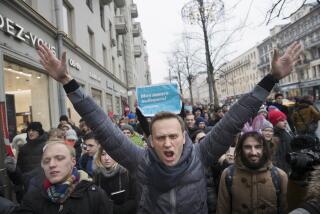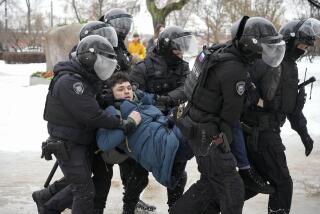Kremlin Clears 4 More Stalin Purge Victims
- Share via
MOSCOW — Two Bolshevik revolutionaries who were among the leading opponents of dictator Josef Stalin were cleared Monday of the alleged crimes for which they were executed more than 50 years ago.
The Soviet Supreme Court annulled the treason convictions of Grigory E. Zinoviev and Lev B. Kamenev, who were both shot in 1936 after a show trial during one of Stalin’s purges.
Two other Bolshevik leaders, Grigory (Yuri) L. Pyatakov and Karl B. Radek, both of whom had links to Leon Trotsky, Stalin’s archrival, were also rehabilitated by the court.
“The state which they were creating 50 years ago is giving them back their honor and their name,” the government newspaper Izvestia said, adding that others convicted in the show trials had also been cleared by the court.
The disclosure and details of the rehabilitations were one of the most searing indictments of the Soviet political system yet to appear in the official press. Izvestia used the rehabilitations to call for development of a new style of politics as the basis for the country’s ambitious reform program.
They are part of a broad effort under Mikhail S. Gorbachev, the Communist Party general secretary, to reassess historical Soviet figures and policies in order to clarify the country’s current debate over its future course.
“The Supreme Court naturally did not discuss the ‘party face’ of the rehabilitated citizens, and it did not evaluate whether they were right or wrong in the old debates,” Izvestia said. “But it did say clearly: They are innocent before the law, the state and the people.”
Zinoviev and Kamenev spent years in exile with V. I. Lenin, the leader of the Bolshevik Revolution in 1917 and founder of the Soviet state. They sided at different times with both Stalin and Trotsky in the power struggle that followed Lenin’s death in 1924.
After Trotsky was forced into exile--he was murdered in Mexico in 1940 by a Stalinist agent--Stalin turned on Zinoviev and Kamenev and had them tried for treason in the first big show trial used to purge the party of Stalin’s opponents. They were convicted and executed in August, 1936, as “enemies of the people.”
At their trials, Zinoviev, Kamenev and others confessed to being members of a “Trotskyist-Zinovievite Center” that had allegedly conspired to kill Stalin on orders from Trotsky. They also confessed to organizing the murder in 1934 of Sergei M. Kirov, the Leningrad party chief.
Execution and Imprisonment
Pyatakov was sentenced to death at the second of the trials in early 1937. Radek was imprisoned for 10 years and died in a Siberian labor camp. Both had confessed to having links with the exiled Trotsky.
Nikolai I. Bukharin, the most prominent of Stalin’s opponents after Trotsky, was shot after he was convicted at the final trial in March, 1938. He was formally rehabilitated in February after a commission was established to examine the cases of Stalin’s victims.
Radio Moscow, commenting on Monday’s decision, said that most people had long ago concluded that the men were not the killers of Kirov, or terrorists.
“But there were still doubts as to whether they were honest revolutionaries and not enemies of the party and state,” the broadcast said. “Now, there is no more room for such doubts.”
In focusing on some of Stalin’s most prominent victims, the present leadership is also seeking to demonstrate its determination to remove all the Stalinist legacy that still burdens the country. The rehabilitations, Izvestia said, are also meant to reassure people that they will not be prosecuted for expressing views divergent from those of the party leadership.
‘A Time of Hard Struggle’
“We are learning democracy, mastering the rules of political discussion,” Izvestia said, and it described the country’s present situation as “a time of hard struggle.”
The purges of the 1930s should be a lesson in political tolerance for the country, Izvestia said, arguing that contrary to traditional thinking here, space should be left for opponents and critics of the leadership to express their views.
This is particularly important in the country’s present political climate, the paper said, anticipating the sharp debates likely to occur at a special party conference this month that will map strategy for future reforms.
It said that party members in the 1920s, when debates were heated and the losers frequently were expelled, “preached intolerance toward the opinions of their opponents and thus gave birth to physical and moral terror.” And it added, “The oppression of those left in the minority led to a situation in which one man crushed the majority.”
Intolerant of Pluralism
The political culture that consequently developed over more than half a century has not tolerated the pluralism that Gorbachev and other reformers believe is essential to work out solutions to the country’s problems.
“A lack of the very notion of personal opinion has created the wild ‘crowd syndrome’ that sanctions any tyranny in the name of the people,” Izvestia commented.
“Discussion has been cut off for a long time about the paths toward building socialism, about the paths of developing the revolution, about the role of the party, about the place of the ruler. It has been restored now, more than half a century later--and from the same place where it was cut off.”
STALIN’S PURGE VICTIMS Grigory E. Zinoviev
Born in the Ukraine in 1883, Zinoviev was a close collaborator of V.I. Lenin in the years leading to the 1917 revolution and one of the era’s most prominent Bolsheviks. He was a member of the five-man Politburo after the revolution and headed the governing body in what is now Leningrad. After Lenin’s death in 1924, he emerged, with Lev B. Kamenev and Josef Stalin, as one of the ruling triumvirate. He also headed the Communist International. During Stalin’s drive to concentrate power in his own hands, Zinoviev and Kamenev briefly joined Leon Trotsky to oppose him. After Stalin consolidated power, Zinoviev denounced Trotsky, but it was too late. He lost his party membership, and in 1935, he was convicted of complicity in the murder of Leningrad party chief Sergei M. Kirov and sentenced to 10 years in prison. A year later, he and 15 others were tried in the first show trial of the Great Purge. Convicted of a series of political crimes, he was executed immediately after that trial in August, 1936.
Lev B. Kamenev
A revolutionary activist during his law school days, Kamenev, who was born in Moscow in 1883, was imprisoned in Siberia in 1902 for his work with student radicals. After his release, he traveled to Europe where he worked for Iskra (The Spark), a revolutionary journal founded by Lenin, and became one of the latter’s closest associates during the Bolsheviks’ rise to power. After Lenin’s death, he at first joined with Zinoviev and Stalin against Trotsky, the leader of the “left opposition.” Then in 1926, he and Zinoviev both reversed themselves, supporting Trotsky’s ultimately unsuccessful effort to thwart Stalin’s growing power. He was expelled from the party three times between 1927 and 1934, and in 1935, he was, like Zinoviev, sentenced to prison for alleged complicity in the slaying of Kirov. In 1936, he was retried in the first show trial of the purge and executed.
Karl B. Radek
A pre-World War I German Socialist, Radek was born in what today is part of Poland. He joined Lenin’s Bolsheviks in the early 1900s. He fought in the Russian Revolution and also tried to organize a revolution in Germany. With Zinoviev, he became one of the top leaders of the Communist International. Radek was expelled from the Communist Party in 1927 on charges of having been a Trotsky supporter. He was later rehabilitated and allowed to help draft the 1936 Soviet constitution and edit the government newspaper Izvestia. But in 1937, he was convicted of treason and is believed to have died in prison about 1940.
(Not pictured)
Grigory L. (Yuri) Pyatakov
A leader of the Ukrainian Communist Party, Pyatakov set up a government in the Russian city of Kursk under orders from Moscow and invaded the Ukraine with Red Army soldiers. He was tried with Radek as a supporter of Trotsky in 1937 and was executed.
More to Read
Sign up for Essential California
The most important California stories and recommendations in your inbox every morning.
You may occasionally receive promotional content from the Los Angeles Times.










